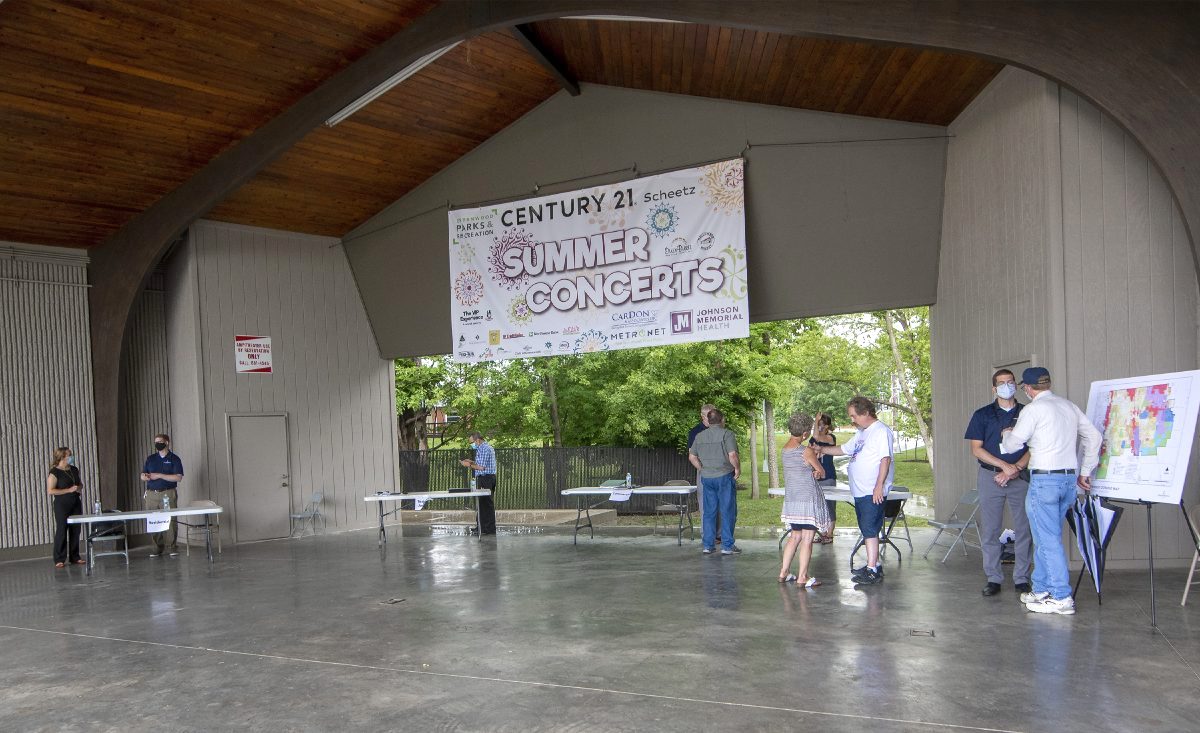Greenwood residents got a first look at the city’s overhaul of its decades-old zoning rules, and the plan will soon be ready to move on to city officials for consideration.
A handful of residents stopped by the outdoor Greenwood Amphitheater Wednesday afternoon to inquire about the city’s new zoning code and see a new map for the first time.
The zoning code is the city’s guide to land use and dimensional specifications for everything from street lights and business signs to how wide a garage can be depending on the square-footage of a home. The current code is nearly four decades old, and city officials worked for the past two years to overhaul the code to better meet the modern needs of a growing Greenwood.
[sc:text-divider text-divider-title=”Story continues below gallery” ]Click here to purchase photos from this gallery
The city paid Cincinnati-based consultant, Calfee Zoning, $198,000 to modernize its zoning rules, in hopes that these new, simplified rules could save residents, developers and its leaders time and, in some cases, money.
The open house consisted of six different tables set up around the stage of the amphitheater, each manned by a city official who could answer questions on topics such as residential and commercial standards, subdivisions and how the changes would affect city projects that are in the works.
Crystal Osborn and her 13-year-old son Arthur were of the few Greenwood residents to attend on a stormy Wednesday afternoon. Arthur was looking to earn his Boy Scouts merit badge for citizenship in the community, so they decided to stop by the open house to see the new plans, Crystal Osborn said.
“This was a good method, given COVID-19 … having it outdoors worked great, and I loved they had the booths you could go to to ask specific questions,” she said.
The proposed final plan for the new rules migrates Greenwood’s old code with new pathways for building and simplified zones. Most commercial, residential and industrial zones would remain virtually the same, according to the zoning map. But one noticeable change is the creation of an Old Town and Old Town Residential district.
Sean Suder, a partner with Calfee, said Old Town Greenwood became the small town that got “swallowed up” by the development around it. So, city officials agreed the area should have its own construction standards that differ from the suburban residential lots in the city, which is what it was grouped with before, he said.
“You have this condition that’s really distinct from anything else around it—it’s the small town,” Suder said. “All of a sudden they were applying suburban standards to your property here and there were all these variances you had to go through.”
Most variance petitions brought to the city’s board of zoning appeals, which reviews all change requests against the current zoning code, were from homeowners or businesses wanting to renovate older properties in the downtown area, said Dale Davis, the city’s planning director.
Simplifying the zoning code and adding more pathways for custom development, ideally, will decrease the amount of variance requests to the board, Davis said.
Matthew Smith has served on the board of zoning appeals since 2018, and potentially limiting the amount of variances coming to the board is a good thing, he said.
“We aren’t elected … it puts us in a hard position as people who are given the responsibility to grant these variances. Anything that adds more pathways is a good thing, in my opinion,” Smith said.
Other key changes to the code would include combining the different residential and commercial zones. Greenwood has five different categories for single-family residential lots, and the new code would trim that to three categories.
Commercial zone categories would also be combined and changed to commercial small, medium or large. The current code has one zone that allows offices buildings only, but no retail sales. That would be done away with and added to the “commercial small” category to give more flexibility to business owners, said Ed Ferguson, a senior planner for the City of Greenwood.
“It allows a little more variety of uses in the different zones and makes it a little more flexible,” Ferguson said.
Another key change would be leveling the standards across the city, Davis said. Standards for architecture and land use were added in overlays to the old code as the city developed over the last few decades, but nothing was changed to make the whole code cohesive city-wide.
Next, the city will compile the public feedback and make any changes to the proposed zoning code, Davis said. Then, the code will go before the city’s advisory plan commission at a public hearing, where the commission will decide whether to send a favorable or unfavorable recommendation to the Greenwood City Council.
The city council will then review the zoning code and decide whether to adopt it.
[sc:pullout-title pullout-title=”Next steps” ][sc:pullout-text-begin]
Here is a look at next steps as the City of Greenwood looks to overhaul its outdated zoning code:
- A public hearing before the Advisory Plan Commission;
- The commission will provide a recommendation to the Greenwood City Council;
- The city council will review the zoning code over the course of several meetings before putting it to a final vote to decide whether to adopt it;
- If any changes are made to the code during city council meetings, it will have to go back to the plan commission for review again.
[sc:pullout-text-end]





